Articles
- Page Path
- HOME > Restor Dent Endod > Volume 31(1); 2006 > Article
- Original Article The comparison of relative reliability on biaxial and three point flexural strength testing methods of light curing composite resin
- Deog-Gyu Seo, Byoung-Duck Roh
-
2006;31(1):-65.
DOI: https://doi.org/10.5395/JKACD.2006.31.1.058
Published online: January 31, 2006
Department of Conservative Dentistry, College of Dentistry, Yonsei University, Korea.
- Corresponding Author: Byoung-Duck Roh. Department of Conservative Dentistry, College of Dentistry, Yonsei University, 134 Shinchon-dong, Seodaemun-gu, Seoul, 120-752, Korea. Tel: 82-2-2228-3146, Fax: 82-2-313-7575, operatys16@yumc.yonsei.ac.kr
Copyright © 2006 Korean Academy of Conservative Dentistry
- 996 Views
- 4 Download
- 9 Crossref
Abstract
-
The possibility of applying a bi-axial flexure strength test on composite resin was examined using three point and bi-axial flexure strength tests to measure the strength of the light-cured resin and to compare the relative reliability using the Weibull modulus.The materials used in this study were light-curing restorative materials, MICRONEW™, RENEW® (Bisco, Schaumburg, USA). The bi-axial flexure strength measurements used the piston-on-3-ball test according to the regulations of the International Organization for Standardization (ISO) 6872 and were divided into 6 groups, where the radius of the specimens were 12 mm (radius connecting the 3-balls: 3.75 mm), 16 mm (radius connecting the 3-balls: 5 mm), and the thickness were 0.5 mm, 1 mm, 2 mm for each radius.The bi-axial flexure strength of the MICRONEW™ and RENEW® were higher than the three point flexure strength and the Weibull modulus value were also higher in all of the bi-axial flexure strength groups, indicating that the bi-axial strength test is relatively less affected by experimental error.In addition, the 2 mm thick specimens had the highest Weibull modulus values in the bi-axial flexure strength test, and the MICRONEW™ group showed no significant statistical difference (p > 0.05). Besides the 2 mm MICRONEW™ group, each group showed significant statistical differences (p < 0.05) according to the thickness of the specimen and the radius connecting the 3-balls.The results indicate that for the 2 mm group, the bi-axial flexure strength test is a more reliable testing method than the three point flexure strength test.
- 1. Anusavice KJ, Hojjatie B. Stress distribution in metal ceramic crowns with a facial porcelain margin. J Dent Res. 1987;66: 1493-1498.ArticlePubMedPDF
- 2. Zidan O, Asmussen E, et al. Tensile strength of restorative resins. Scand J Dent Res. 1980;88: 285-289.ArticlePubMed
- 3. Bryant RW, Mahler DB. Modulus of elasticity in bending of composites and amalgams. J Prosthet Dent. 1986;56: 243-248.ArticlePubMed
- 4. Radford KC, Lange FF. Loading factors for the biaxial flexure test. J Am Ceram Soc. 1978;61(5-6):211-213.
- 5. Han BS. Al2O3 selamigseu-ui yeolchunggyeog pagoe geodonggwa yeol-eunglyeog haeseog. 1997;Yeonsei Univ. Graduate School; doctorate thesis.
- 6. Mckinney KR, Herbert CM. Effect of surface finish on structual ceramic failure. J Am Ceram Soc. 1970;53: 513-516.
- 7. Kirstein AF, Woolley RM. Symmetrical bending of thin circular elastic plates of equally spaced point supports. J Res Nall Burstds. 1967;71(C):1-10.
- 8. Kao R, Perrone N, Capps W. Large-deflection solution of the coaxial-ring-circular-glass-plate flexure problem. J Am Ceram Soc. 1971;54: 566-571.Article
- 9. Shetty DK, Roesinfield AR, Duckworth WH, Held PR. A Biaxial-flexure test for evaluating ceramic strength. J Am Ceram Soc. 1983;66: 36-42.
- 10. Marshall DB. An improved biaxial flexure test of ceramics. Am Ceram Soc Bull. 1980;59: 551-553.
- 11. Lamon J. Statistical approaches to failure for ceramic reliability assessment. J Am Ceram Soc. 1988;71: 106-112.Article
- 12. Wilshaw TR. Measurement of tensile strength of ceramics. J Am Ceram Soc. 1968;51: 111-117.Article
- 13. Park SE. Biaxial fracture behavior and simulation for prediction of fatigue lifetime in alumina by ball-on-3ball test. 2000;Yeonsei Univ. Graduate School; doctorate thesis.
- 14. Shetty DK, Roesinfield AR, Macguire P, Bansal GK, Duckworth WH. Biaxial flexure tests for ceramics. Am Ceram Soc Bull. 1980;59(12):1193-1197.
- 15. Shetty DK, Roesinfield AR, Bansal GK, Duckworth WH. Biaxial fracture stuies of a glass-ceramic. J Am Ceram Soc. 1981;64(1):1-4.
- 16. Williams RM, Swank LR. Use of Weibull statics to correlate MOR, Ball-on-ring, and rotational fast fracture tests. J Am Ceram Soc. 1983;66(11):756-768.
- 17. Ham-Su R, Wilkinson DS. Strength of tape cast and laminated ceramics. J Am Ceram Soc. 1995;78(6):1580-1584.Article
- 18. Chiang MYM, Tesk JA. Differences: Hertz vs finite element calculation for diametral tensile strength. J Dent Res. 1989;68: 341-348.
- 19. Ban S, Anusavice KJ. Influence of test method on failure stress of brittle dental materials. J Dent Res. 1990;69(12):1791-1799.ArticlePubMedPDF
REFERENCES
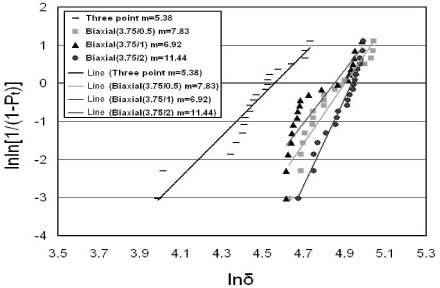
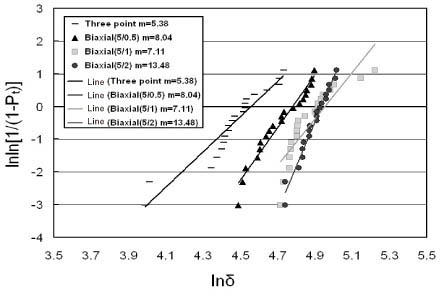
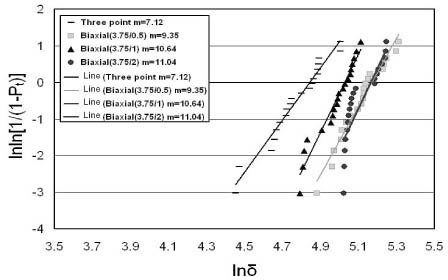
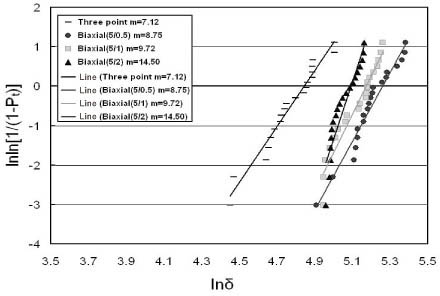
If the alphabet is different, significant difference at α= 0.05 (between the thickness on the same diameter).
*indicates significant difference at α= 0.05 (between the diameter on the same thickness).
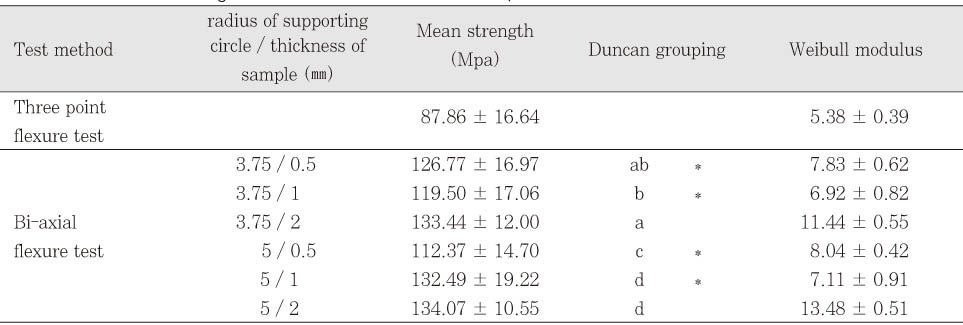
If the alphabet is different, significant difference at α= 0.05 (between the thickness on the same diameter).
*indicates significant difference at α= 0.05 (between the diameter on the same thickness).
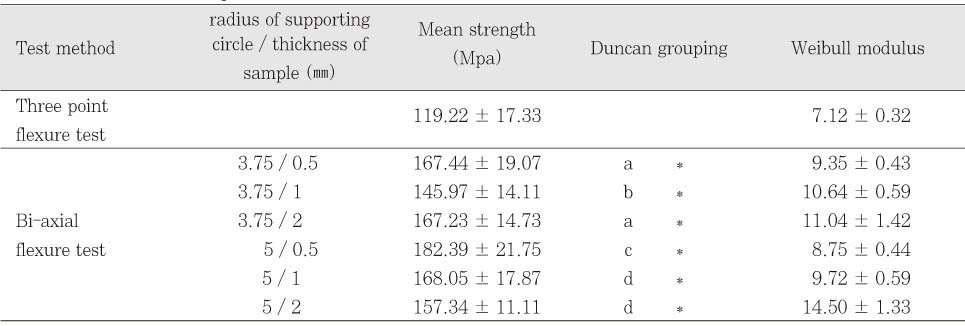
Tables & Figures
REFERENCES
Citations

- Remineralization of demineralized teeth enamel with nHAp and nHAp-NaF-PEO nanocomposite
Nazifa Zaman Khan, S. Manjura Hoque, Harinarayan Das, Arup Kumar, Rafiqul Islam, Mozammal Hossain
Biomedical Engineering Advances.2025; 10: 100192. CrossRef - Mechanical properties of CAD/CAM polylactic acid as a material for interim restoration
Won-Il Choi, Lee-gang Yoo, Yu-ri Kim, Bock-Young Jung
Heliyon.2023; 9(4): e15314. CrossRef - The comparisons of layers and the effect of additional firings on flexural strength and translucency of 5Y-ZP
Hyung-Joon Kim, Soo-Yeon Shin
Journal of Dental Rehabilitation and Applied Science.2021; 37(3): 111. CrossRef - Effect of coloring liquids on biaxial flexural strength of monolithic zirconia
Chaeyul Jung, Min-Jeong Kim, Jae-Hyun Kim
The Journal of Korean Academy of Prosthodontics.2021; 59(2): 190. CrossRef - Mechanical Properties and Reliability of Sand Casting 3D Printing Materials
Hyeon Jin Son, Seongwan Jang, Hwan Jong Lee, Jeong Jik Yang, Yeong Geun Jeong, Chang-Jun Bae
Korean Journal of Materials Research.2020; 30(1): 38. CrossRef - Comparison analysis of fracture load and flexural strength of provisional restorative resins fabricated by different methods
Won-Tak Cho, Jae-Won Choi
The Journal of Korean Academy of Prosthodontics.2019; 57(3): 225. CrossRef - Effect of Two Polishing Systems on Surface Roughness, Topography, and Flexural Strength of a Monolithic Lithium Disilicate Ceramic
Mahshid Mohammadibassir, Mohammad Bagher Rezvani, Hossein Golzari, Elham Moravej Salehi, Mohammad Amin Fahimi, Mohammad Javad Kharazi Fard
Journal of Prosthodontics.2019;[Epub] CrossRef - Characteristics according to the Amount of HAp Added in Resin for Tooth Repair
Sungu Hwang, Jinhyuck Lim, Suchak Ryu
Journal of the Korean Ceramic Society.2019; 56(6): 521. CrossRef - Flexural strength and microstructure of two lithium disilicate glass ceramics for CAD/CAM restoration in the dental clinic
Suk-Ho Kang, Juhea Chang, Ho-Hyun Son
Restorative Dentistry & Endodontics.2013; 38(3): 134. CrossRef
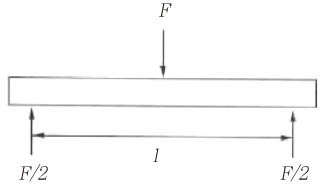
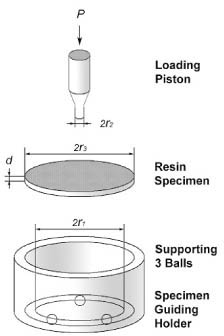




Figure 1
Figure 2
Figure 3
Figure 4
Figure 5
Figure 6
Light cured composite resin used in this study
Mean flexure strength and Weibull modulus of three point flexure test and biaxial flexure test
If the alphabet is different, significant difference at α= 0.05 (between the thickness on the same diameter).
*indicates significant difference at α= 0.05 (between the diameter on the same thickness).
Mean flexure strength and Weibull modulus of three point flexure test and biaxial flexure test
If the alphabet is different, significant difference at α= 0.05 (between the thickness on the same diameter).
*indicates significant difference at α= 0.05 (between the diameter on the same thickness).
If the alphabet is different, significant difference at α= 0.05 (between the thickness on the same diameter). *indicates significant difference at α= 0.05 (between the diameter on the same thickness).
If the alphabet is different, significant difference at α= 0.05 (between the thickness on the same diameter). *indicates significant difference at α= 0.05 (between the diameter on the same thickness).

 KACD
KACD



 ePub Link
ePub Link Cite
Cite

